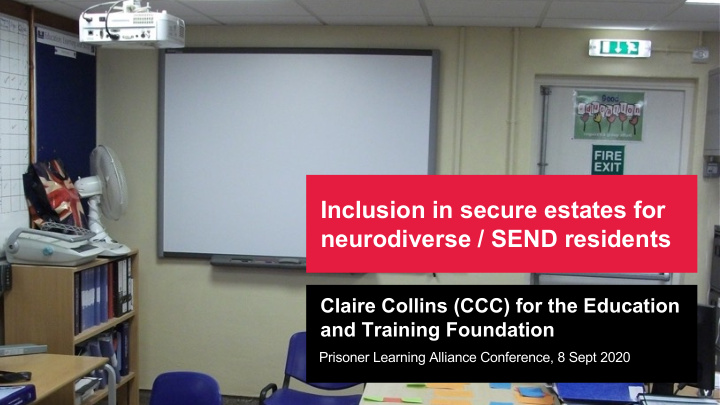



Inclusion in secure estates for neurodiverse / SEND residents Claire Collins (CCC) for the Education and Training Foundation Prisoner Learning Alliance Conference, 8 Sept 2020
Our workshop space and a chance to meet others
Room orientation • Speaker and gallery views • Using the chat function • Turning your camera on and off • Muting your microphone • Making it easier to see the speaker when viewing slides • Recording 3 Delivered by ccConsultancy for the Education and Training Foundation
A moment of reflection… What do you hope, and expect, to learn in this workshop? To what Think about this for a moment and jot it extent was down if you like. this activity inclusive? Jump into a breakout room for 3 minutes and find out what others hope to cover in the next hour…. 4 Delivered by ccConsultancy for the Education and Training Foundation
Session Objectives To what extent do they meet your hopes/ expectations?
Session Objectives • Define areas of focus when supporting residents with special educational needs and disabilities (SEND) / neurodiversity • Explore resources and projects for SEND/ neurodiverse prison residents • Learn about the Education and Training Foundation’s (ETF’s) Centres for Excellence in SEND. 6 Delivered by ccConsultancy for the Education and Training Foundation
SEND, LDD and Neurodiversity Language and definitions
- Special Educational Needs and Disabilities (SEND) - Learning Difficulties and Disabilities (LDD) - Neurodiversity Take a moment, think about what these labels mean to you…. Do the labels we use matter? 8 Delivered by ccConsultancy for the Education and Training Foundation
A definition of neurodiversity… “In its simplest definition, neurodiversity is the concept that, with regards to the human brain and nervous system, people don’t all end up the same. In other words, it’s a concept that describes individuality and uniqueness in cognitive functioning.” (The Neurodiversity Paradigm, Nick Walker (2017) Found at: http://neurocosmopolitanism.com/ 9 Delivered by ccConsultancy for the Education and Training Foundation
“The idea that there is one ‘normal’ or ‘healthy’ type of brain or one ‘right’ style of functioning is no more valid than the idea that there is one ‘normal’ or ‘right’ gender, race or culture. The classification of neurodivergence (i.e. Autism, ADHD, Dyslexia) as medical, has no scientific base and instead reflects cultural prejudice and oppresses those labelled as such.” (IBID) 10 Delivered by ccConsultancy for the Education and Training Foundation
The 4 areas of need from the 2014 SEND Code of Practice • Communication and Interaction • Learning and Cognition • Social, Emotional and Mental Health • Sensory and Physical Impairments 11 Delivered by ccConsultancy for the Education and Training Foundation
SEND Pathways Communication + Learning + Social, Sensory + Interaction Cognition Emotional + Physical Mental Health Impairments Autistic Spectrum Dyslexia Self-harm Hearing + Visual Disorder Impairments Dyscalculia Behaviour Speech + Language disorders Duchenne Impairments Dysgraphia Muscular ADD Dystrophy Tourette Syndrome ADHD Cerebral Palsy Depression 12 Delivered by ccConsultancy for the Education and Training Foundation
Areas we can focus on: 1. literacy and language 2. memory and organisation What support 3. co-ordination strategies 4. numeracy could we use in prison 5. confidence and self-esteem education, 6. promoting positive behaviours and work and training? concentration 7. hearing / eyesight 13 Delivered by ccConsultancy for the Education and Training Foundation
Example area of focus: Memory and organisation Our auditory memory is our ability to retain and recall information that we hear. It allows us to understand longer, more complex instructions and to listen and acquire new information. Learners with reduced auditory memory can find it extremely challenging to follow instructions and retain learning. Photo by David Matos on Unsplash Delivered by ccConsultancy for the Education and Training Foundation
Memory and organisation – suggested strategies • Focus on learning strategies that maximise memory and improve recall (e.g. spaced rehearsal) • Make learning links • Encourage repetition, lists and diaries • Suggest people write things down or visualise as a picture or object • Make use of colour, mind maps and chunking • Use digital tools that help with planning, organisation and schedules (yes, this is possible in prison!) Delivered by ccConsultancy for the Education and Training Foundation
Support/ resources ETF Projects and Centres for Excellence in SEND
The Mindfulness Toolkit
The Mindfulness Toolkit
Find out more… https://wke.lt/w/s/BbGrq Resources at: https://www.excellencegateway.org.uk/content/etf2859
Centres for Excellence in SEND 3 Centres for Excellence in SEND, including Weston College (also a PEF provider) Support for leaders, curriculum development and CPD Collection of resources and guides Read this helpful summary of the support available Access the SEND area on the Excellence Gateway 20 Delivered by ccConsultancy for the Education and Training Foundation
Claire Collins Claire.Collins@ccConsultancy.co.uk @ClaireCollins8 ETFOUNDATION.CO.UK THANK YOU ANY QUESTIONS?
Recommend
More recommend